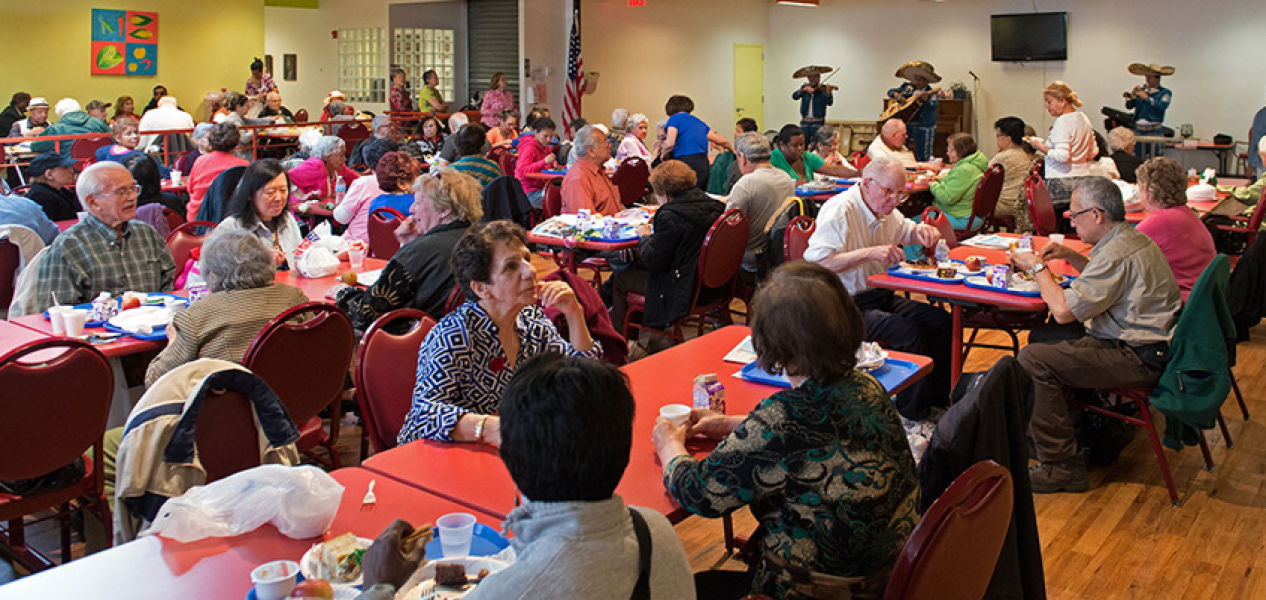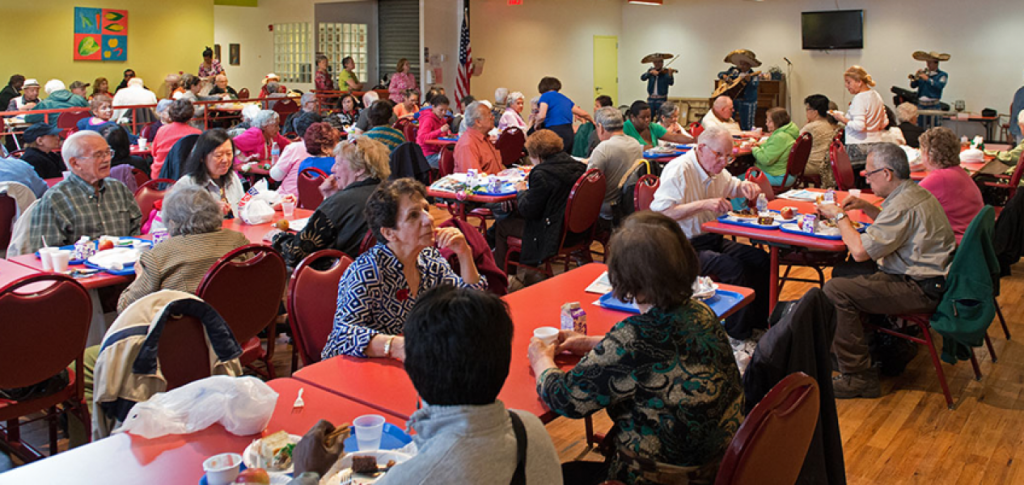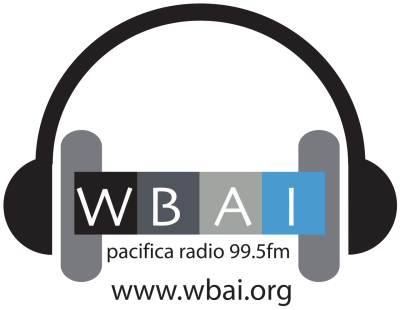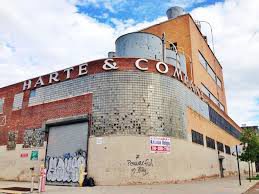
The second in a two-part look at family caregiving in New York City:
A 15-minute ride from midtown Manhattan on the Number 7 train takes you to the community of Sunnyside. This thriving western Queens neighborhood has long been home to generations of immigrants — from the Irish and Italian workers who settled here after the opening of the Queensboro Bridge in 1909, to the multicultural and vibrant Asian, South Asian and Latin American communities that call Sunnyside home today.
A short walk from the 40th street station is Sunnyside Community Services. What began in 1974 as a tiny senior center in a church basement, is now the largest community-based social services agency in western Queens. It serves over 14,000 residents of all ages, including 10,000 seniors, on premises and through its home care network.
Approximately 60 percent of those coming into the Center are Latino, according to Executive Director Judith Zangwill. For every older adult and family caregiver, the goal is to provide another layer of support, information and a bridge to services.
“We pride ourselves on a whole continuum of senior services,” she said. “If the entry point is the Center for Active Older Adults, then as a senior’s needs change, which they will, they can move seamlessly from one service to the next.”
The Center offers geriatric mental health, a caregivers program, case management, home care, adult day services, friendly visiting for homebound seniors, and a pet pal program, which helps older adults care for and keep their pets. “It’s a rich continuum,” she said.
It is also a place where family caregivers can find respite. That is especially important for many Latino caregivers, who may be hesitant to seek help, although they struggle with caring for an older parent or spouse who is frail, chronically ill, or in declining health.
“With Hispanic family caregivers, caregiving is ingrained in the culture and in the family unit,” said Shyvonne Noboa, LMSW, Director of the Western Queens Caregiver Network (WQCN). WQCN services are coordinated through the Sunnyside Center, providing information, referrals, counseling, and other practical and emotional assistance to caregivers in multiple languages.
“As this demography is living longer, caregivers are dealing with more multiple chronic illnesses and with Alzheimer’s disease. They find themselves obligated to go outside of their culture and their community to seem support services.”
When Hispanic caregivers first come to the Sunnyside Center, the first step is to help them deal with their feelings about being a caregiver, because many don’t see themselves in that formal role. “Once they accept that, we can move on to discuss what services we can put in place for the person they’re caring for,” Noboa said. Her Ecuadorian heritage, upbringing and fluency in Spanish helps caregivers feel that their concerns are understood.
The Center has one of the only Spanish-speaking caregiver support groups in western Queens, which helps family members more easily discuss their challenges. The Center may help the care recipient receive meals through case management, refer them to adult day care, home care, or provide individual respite. “Relieving the burden is of primary essence,” Noboa said.
Common adult day services like yoga, bingo, discussion groups and creative writing are offered. Equally important, said Zangwill, are the services for frail elderly and those with Alzheimer’s or other cognitive impairments. It helps them to remain as active as possible for as long as possible. “We provide a very home-like environment, with a kitchen, living area, and even showers,” Zangwill said. “It helps caregivers overcome their reluctance to leave their loved one in what they still perceive to be an institutional setting.”
Educating caregivers, respecting beliefs
Part of the challenge is educating caregivers about respite care, Noboa said. ”We help them understand that these services actually help them to be a better caregiver.”
Another key aspect of the education process is addressing a caregiver’s belief system. “Another ingrained cultural issue is spirituality,” she said. “For many members, we need to educate them about medications, Alzheimer’s disease, and we tell them that while their faith will support them, there are other ways to support your loved one too. Discussing spirituality in our support groups is a real positive for them.”
Often the adult child moves in with mom or dad, or they get a new place together. That adds to the ease of caregiving by eliminating travel, but it can also add to the stress. The constant caregiving role sometimes makes caregivers feel like they’re losing their own identity. “We remind them that they need to take time out and care for themselves or they won’t be of use to the person they’re caring for,” Noboa said.
Caregivers get help navigating the health system and learn what services will help keep their loved one home for as long as possible.
This is essential for those who must take time off from work, often unpaid, to manage the many complex caregiving needs like multiple doctor appointments. “A comprehensive, holistic program is so critical,” said Zangwill. “We do the best we can, providing caregivers with both emotional support and help navigating the systems, from beginning to end.”
Funding of course, is an ongoing challenge. While the New York City Department for Aging is a “great partner,” Noboa said there has been no new funding since the Older Americans Act was last reauthorized in 2011. “We need more money to support informal free care and training caregivers. Funding is critical for respite care and how to navigate the system.”
An overwhelming need
It’s difficult enough caring for an older loved one without language and cultural barriers, but among non-native populations, “the need is overwhelming and the supply doesn’t come close” said Zangwill. “Housing, elder abuse, medication management, so many issues are connected.” Many of these problems are magnified in the immigrant population, she said, including how to navigate the system, advocate for themselves and overcoming language barriers.
One benefit to accessing services through Sunnyside is that “once trust is established, caregivers can stay within the same organization,” Zangwill said. Whether it’s adult day care or home care, “once that trust is there, it’s a safe feeling and they can access the continuum of care.” Agencies which are embedded in the community like Sunnyside are the ones who best know the needs of that community and best able to find place-based services.
But an aging population in New York City means a greater need for services in the years to come. “We need more social workers in community settings,” said Noboa. “Clients keep coming in on a daily and weekly basis. It’s a challenge but we do it, with a lot of support from our partners in western Queens.” She’s optimistic that future city budgets will reflect an understanding of staffing and funding needs.
“This is a 21st century issue for women in the workforce,” she said. “The program works, it’s there to support and understand cultural differences. We need a lot more support — just spend a day in our shoes and you will see why.”
The Center serves as a “second home” for many caregivers. “They feel safe, nurtured…everybody is here to support them. Our caregivers feel it’s a place they can let their guard down,” said Noboa.
Caregivers who come to Sunnyside know they’re not in it alone, said Zangwill. “One of our primary goals with our older population is to keep them in their communities with dignity. Most people want to stay in their homes, and we help them be able to do that.”
Neighborhood organizations like this are a pivotal model in providing comprehensive, holistic support for family caregivers and older adults. To find a similar center, caregivers can search the Eldercare Locator or contact their local Area Agency on Aging.
Liz Seegert is supported by a Journalists in Aging fellowship, a collaboration of New America Media and the Gerontological Society of America, sponsored by the Silver Century Foundation.
This story originally aired on WBAI-FM, NYC. Listen here.
Podcast: Play in new window | Download





